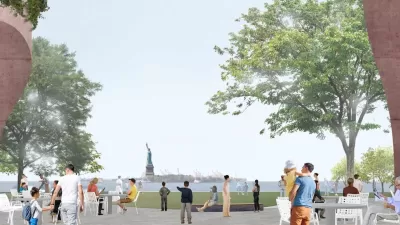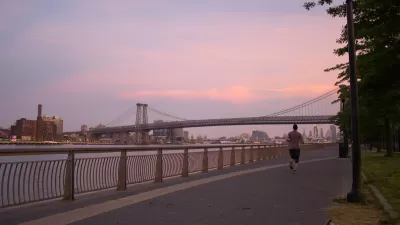For those who want it, the Netherlands is willing to share the fruits of its centuries-long relationship with the unruly seas. In Rotterdam, lots of local urban solutions are also on display.

With a good portion of its urban population living below sea level, the Netherlands has a lot to offer when it comes to rising seas. While certain national governments may be disinclined to listen, there are plenty of lessons on hand for cities.
Michael Kimmelman covers a Dutch export that's rapidly gaining international currency: climate change expertise. Regarding flood management, the modern Dutch strategy "is, in essence, to let water in, where possible, not hope to subdue Mother Nature: to live with the water, rather than struggle to defeat it. The Dutch devise lakes, garages, parks and plazas that are a boon to daily life but also double as enormous reservoirs for when the seas and rivers spill over."
Kimmelman discusses the port city of Rotterdam and its current campaign to "cast itself as a model of inventive urbanism." While the city faces social and ethnic challenges, it seems to have the threat of flooding well in hand. Strategies include the Maeslantkering, "a monumental gate with two arms, resting on either side of the canal, each arm as tall and twice as heavy as the Eiffel Tower, " as well as hybrid structures like the Dakpark, a dike that "has a shopping center, which the neighborhood needed, and a park on the roof."
The piece closes with some observations on New York City from a Dutch expert. "To the Dutch, what's truly incomprehensible [...] is New York after Hurricane Sandy, where too little has been done to prepare for the next disaster. People in the Netherlands believe that the places with the most people and the most to lose economically should get the most protection."
FULL STORY: The Dutch Have Solutions to Rising Seas. The World Is Watching.

Trump Administration Could Effectively End Housing Voucher Program
Federal officials are eyeing major cuts to the Section 8 program that helps millions of low-income households pay rent.

Planetizen Federal Action Tracker
A weekly monitor of how Trump’s orders and actions are impacting planners and planning in America.

Ken Jennings Launches Transit Web Series
The Jeopardy champ wants you to ride public transit.

Washington Legislature Passes Rent Increase Cap
A bill that caps rent increases at 7 percent plus inflation is headed to the governor’s desk.

From Planning to Action: How LA County Is Rethinking Climate Resilience
Chief Sustainability Officer Rita Kampalath outlines the County’s shift from planning to implementation in its climate resilience efforts, emphasizing cross-departmental coordination, updated recovery strategies, and the need for flexible funding.

New Mexico Aging Department Commits to Helping Seniors Age ‘In Place’ and ‘Autonomously’ in New Draft Plan
As New Mexico’s population of seniors continues to grow, the state’s aging department is proposing expanded initiatives to help seniors maintain their autonomy while also supporting family caregivers.
Urban Design for Planners 1: Software Tools
This six-course series explores essential urban design concepts using open source software and equips planners with the tools they need to participate fully in the urban design process.
Planning for Universal Design
Learn the tools for implementing Universal Design in planning regulations.
Heyer Gruel & Associates PA
Ada County Highway District
Institute for Housing and Urban Development Studies (IHS)
City of Grandview
Harvard GSD Executive Education
Toledo-Lucas County Plan Commissions
Salt Lake City
NYU Wagner Graduate School of Public Service





























